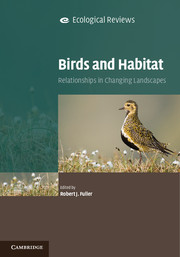Book contents
- Frontmatter
- Contents
- List of Contributors
- Preface
- Part I The complexity of patterns and processes
- Chapter One The bird and its habitat: an overview of concepts
- Chapter Two Habitat quality and habitat occupancy by birds in variable environments
- Chapter Three Spatial variation and temporal shifts in habitat use by birds at the European scale
- Chapter Four Mechanisms and processes underlying landscape structure effects on bird populations
- Chapter Five Avian responses to transitional habitats in temperate cultural landscapes: woodland edges and young-growth
- Chapter Six Habitat associations of birds in complex changing cultural landscapes
- Chapter Seven The importance of habitat heterogeneity at multiple scales for birds in European agricultural landscapes
- Part II Case studies of habitat use and selection
- Part III Wider perspectives
- Species index
- Subject index
- References
Chapter Six - Habitat associations of birds in complex changing cultural landscapes
Published online by Cambridge University Press: 05 December 2012
- Frontmatter
- Contents
- List of Contributors
- Preface
- Part I The complexity of patterns and processes
- Chapter One The bird and its habitat: an overview of concepts
- Chapter Two Habitat quality and habitat occupancy by birds in variable environments
- Chapter Three Spatial variation and temporal shifts in habitat use by birds at the European scale
- Chapter Four Mechanisms and processes underlying landscape structure effects on bird populations
- Chapter Five Avian responses to transitional habitats in temperate cultural landscapes: woodland edges and young-growth
- Chapter Six Habitat associations of birds in complex changing cultural landscapes
- Chapter Seven The importance of habitat heterogeneity at multiple scales for birds in European agricultural landscapes
- Part II Case studies of habitat use and selection
- Part III Wider perspectives
- Species index
- Subject index
- References
Summary
Habitat is a key factor limiting the distribution of bird species, but how we define species habitat selection depends on the scale of the analysis and the structure of the environment (Chapter 1). In regions such as western Europe where the landscape is highly man-modified, the scale and configuration of habitat patches is usually markedly different from that in more natural landscapes, with a corresponding difference in how birds respond and in our perceptions of their habitat associations. In such historically fragmented and modified landscapes, species may have been forced to adapt to a wider range of habitats than is the case in less-modified landscapes (Chapter 3). This may have consequences for the extent to which many species in long-established cultural landscapes can be regarded as true habitat specialists.
This chapter discusses how birds use European cultural landscapes, taking Britain as an example. We first outline the processes that have operated within these landscapes to influence the pattern, availability and quality of habitat for birds. We then discuss approaches and constraints to classifying birds by their apparent habitat associations. Finally, we analyse patterns of habitat use at different scales for species widely considered as generalists and specialists of certain habitats, and assess the robustness of these classifications. Classically, specialist species are those whose survival and/or breeding performance depends on a relatively narrow resource base or whose impact or functional role within their environment is relatively narrow, whereas generalists utilise a wider range of resources or have wider or multiple functional roles (reviewed by Devictor et al., 2010). However, as discussed by Devictor et al. (2010), the use of these terms in practice has been complicated by numerous re-definitions and permutations (at multiple levels, from individuals through to populations, and across spatial scales) by many different authors. Recent work (Julliard et al., 2006; Devictor et al., 2008) has been successful in applying a particular definition of a species specialisation index in relation to responses to habitat fragmentation and disturbance, but this still required a priori definition of habitat types.
- Type
- Chapter
- Information
- Birds and HabitatRelationships in Changing Landscapes, pp. 150 - 176Publisher: Cambridge University PressPrint publication year: 2012
References
- 3
- Cited by



